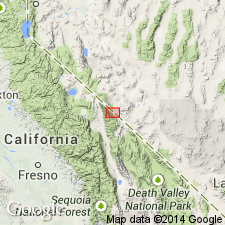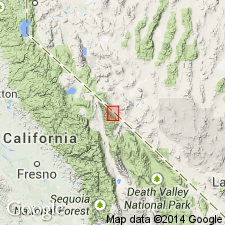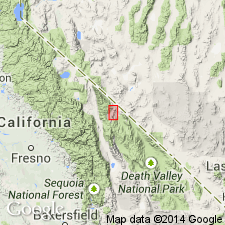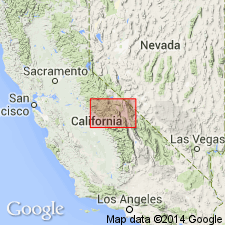
- Usage in publication:
-
- Cottonwood porphyritic adamellite
- Modifications:
-
- Named
- Dominant lithology:
-
- Granite
- AAPG geologic province:
-
- Sierra Nevada province
Summary:
[Probably named for Cottonwood Creek, Mt. Barcroft 15' quad White Mtns, central Sierra Nevada, CA]. [no type designated]. Figure map shows Cottonwood porphyritic adamellite in area near Cottonwood Creek and in isolated patches in SE foothills of quad. Contains light-gray potassic feldspar megacrysts (about 30%); is distinctive because of its consistent and uniform porphyritic texture. Eastern outcrops in contact with McAfee adamellite (new) and Quaternary alluvium. Bordering the west mass are 2 facies of McAfee on east and sedimentary rocks on west. Figure map shows Jurassic age.
Source: GNU records (USGS DDS-6; Menlo GNULEX).

- Usage in publication:
-
- Cotton porphyritic adamellite
- Modifications:
-
- Revised
- AAPG geologic province:
-
- Sierra Nevada province
Summary:
[Cottonwood porphyritic adamellite of Emerson (1966)] here informally called Cottonwood pluton. Shown on sketch map in Mt. Barcroft 15' quad in White Mtns, CA. Described as light-colored, uniformly porphyritic with big phenocrysts of potassium feldspar, everywhere speckled with small mafic zenoliths. Local abundance of large aplite bodies. Weathers into hummocky topography.
Source: GNU records (USGS DDS-6; Menlo GNULEX).

- Usage in publication:
-
- Cottonwood Porphyritic Adamellite
- Modifications:
-
- Revised
- AAPG geologic province:
-
- Sierra Nevada province
Summary:
Cottonwood Porphyritic Adamellite (Emerson, 1966) and Cottonwood pluton (Krauskopf, 1968) is here considered the northern end of Beer Creek pluton which is shown on figure map as quartz monzonite of Beer Creek. Age of quartz monzonite is 176 to 150 Ma (McKee and Nash, 1967; Crowder and others, 1973).
Source: GNU records (USGS DDS-6; Menlo GNULEX).

- Usage in publication:
-
- Cottonwood Granite*
- Modifications:
-
- Redescribed
- AAPG geologic province:
-
- Sierra Nevada province
Summary:
Originally called Cottonwood Porphyritic Adamellite by Emerson (1966). Name here changed to Cottonwood Granite to reflect nomenclature of IUGS classification (Streckeisen, 1973). Is unit of Soldier Pass Intrusive Suite. Is light gray, medium to coarse grained and has seriate to porphyritic texture. Intrudes granodiorite of Beer Creek. Is intruded by Cretaceous granites of McAfee Creek and Indian Garden Creek. U-Pb age on zircon (incorrectly reported to be from granodiorite of Beer Creek) yields 168 Ma. Age is Middle Jurassic.
Source: GNU records (USGS DDS-6; Menlo GNULEX).
For more information, please contact Nancy Stamm, Geologic Names Committee Secretary.
Asterisk (*) indicates published by U.S. Geological Survey authors.
"No current usage" (†) implies that a name has been abandoned or has fallen into disuse. Former usage and, if known, replacement name given in parentheses ( ).
Slash (/) indicates name conflicts with nomenclatural guidelines (CSN, 1933; ACSN, 1961, 1970; NACSN, 1983, 2005, 2021). May be explained within brackets ([ ]).

